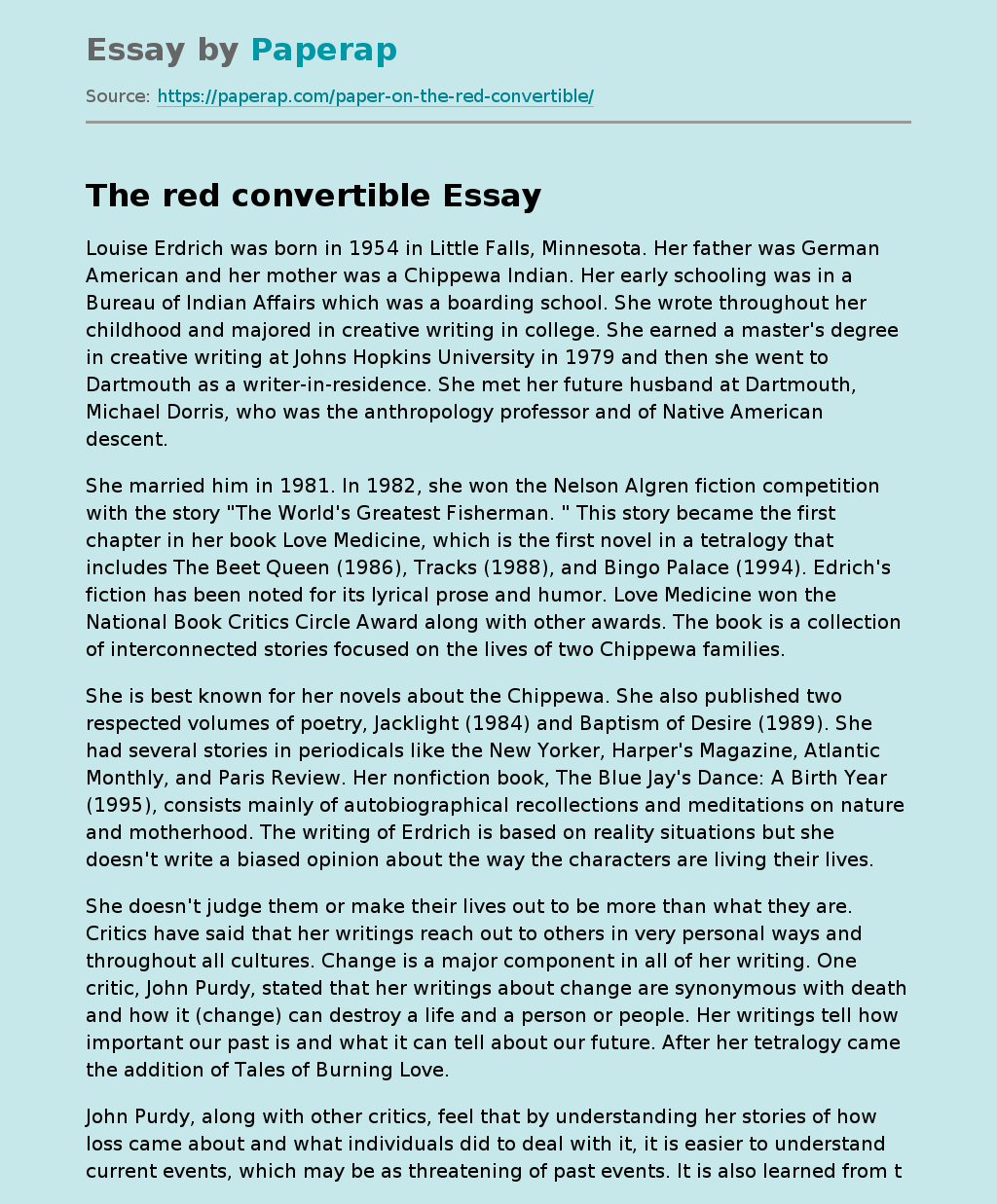The red convertible
Louise Erdrich was born in 1954 in Little Falls, Minnesota. Her father was German American and her mother was a Chippewa Indian. Her early schooling was in a Bureau of Indian Affairs which was a boarding school. She wrote throughout her childhood and majored in creative writing in college. She earned a master’s degree in creative writing at Johns Hopkins University in 1979 and then she went to Dartmouth as a writer-in-residence. She met her future husband at Dartmouth, Michael Dorris, who was the anthropology professor and of Native American descent.
She married him in 1981. In 1982, she won the Nelson Algren fiction competition with the story “The World’s Greatest Fisherman. ” This story became the first chapter in her book Love Medicine, which is the first novel in a tetralogy that includes The Beet Queen (1986), Tracks (1988), and Bingo Palace (1994). Edrich’s fiction has been noted for its lyrical prose and humor. Love Medicine won the National Book Critics Circle Award along with other awards.
The book is a collection of interconnected stories focused on the lives of two Chippewa families.
She is best known for her novels about the Chippewa. She also published two respected volumes of poetry, Jacklight (1984) and Baptism of Desire (1989). She had several stories in periodicals like the New Yorker, Harper’s Magazine, Atlantic Monthly, and Paris Review. Her nonfiction book, The Blue Jay’s Dance: A Birth Year (1995), consists mainly of autobiographical recollections and meditations on nature and motherhood. The writing of Erdrich is based on reality situations but she doesn’t write a biased opinion about the way the characters are living their lives.
She doesn’t judge them or make their lives out to be more than what they are. Critics have said that her writings reach out to others in very personal ways and throughout all cultures. Change is a major component in all of her writing. One critic, John Purdy, stated that her writings about change are synonymous with death and how it (change) can destroy a life and a person or people. Her writings tell how important our past is and what it can tell about our future. After her tetralogy came the addition of Tales of Burning Love.
John Purdy, along with other critics, feel that by understanding her stories of how loss came about and what individuals did to deal with it, it is easier to understand current events, which may be as threatening of past events. It is also learned from the novels that loss doesn’t always mean the end it may be the beginning. Another critic, William J. Scheick, had a different perspective than most critics on the four novels. He stated, “Louise Erdrich’s four novels are collections of loosely connected stories associated more by the generational interaction of the people they concern than by any substantial development of plot.
These works lack a conventional structure comprised of a beginning, middle, and end. And instead of decidedly central protagonists, these works present many characters whose memories and identities are as loosely connected as are the stories in which they appear. ” Later in his critique it is learned that he does respect and appreciate her writing, he just doesn’t care for the structure. As you read in her short story The Red Convertible you can clearly see that she wrote about the way that the Chippewa lived in a truthful manner.
She includes nature, family and non-family relations in this story as she does in other writings. She uses symbolism in The Red Convertible that relates directly to the Chippewa culture. The title of the story uses the color red and it related to several parts of the story like the river, the car, Red Tomahawk and the Red Sticks. Henry wanted to give the car to Lymon but he didn’t want it because he knew that it was a gift and gifts were given by the Chippewa in the event of a death. The represented a “curative charm” for the brothers.
It was something that was supposed to represent Henry and his well being. Lymon thought that if he made sure that Henry did something with the car that he would get better even though he didn’t. Henry’s dance that is written about is another part of the Chippewa culture that Erdrich often writes about. Dancing is an important part of Native American culture. There seems to be a dance for everything. I think that Henry’s dance had to do with the war and how he couldn’t deal with being sent to it and now he wanted to die. It is hard to fight an American war when you don’t consider yourself to be an American.
It is not hard to understand why all cultures enjoy Erdrich’s writing. She touches mothers with writings about pregnancy, childbirth, and early infancy. She gets parents to remember raising their own children and the experiences that they had. She focuses on life cycles, which is virtually everything around us because everything has a life cycle. In 1996 she published her first children’s book, Grandmother’s Pigeon, a story a stubborn grandmother who leaves her family in the middle of the families vacation and she rides a porpoise back to Greenland.
The book has received considerable recognition. Since 1984 she has written or co-authored ten major books, edited Best American Stories of 1993, won numerous literary prizes, and gained a substantial amount of scholarly attention. She did this while raising three adopted children learning disabilities, bearing three daughters, and dealing with the deaths of her oldest, adopted son and two grandparents. In 1996 she was separated from Dorris and on April 10th of 1997 he committed suicide. Today it is said that she and her children are doing well.
The red convertible. (2017, Dec 12). Retrieved from https://paperap.com/paper-on-the-red-convertible/

